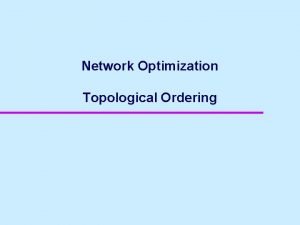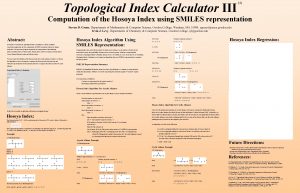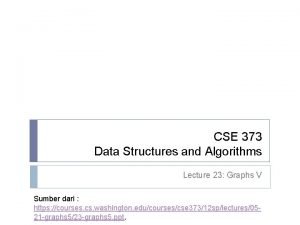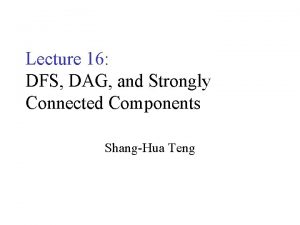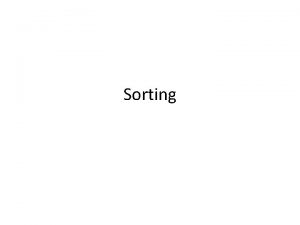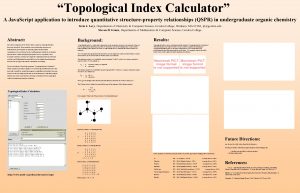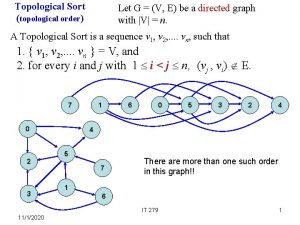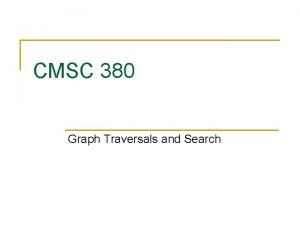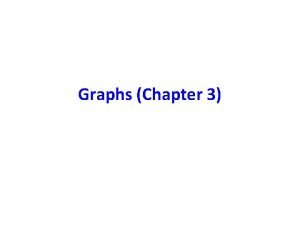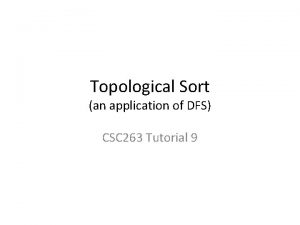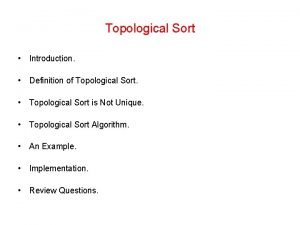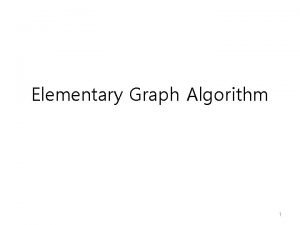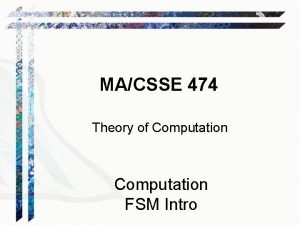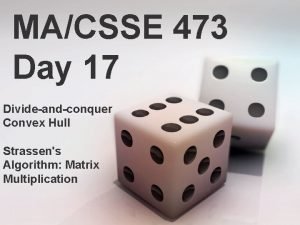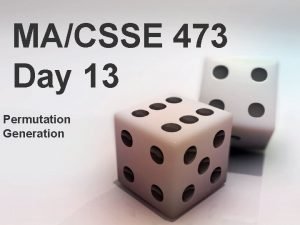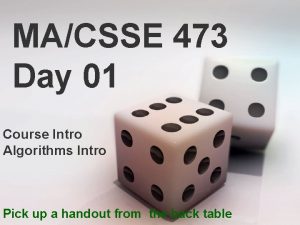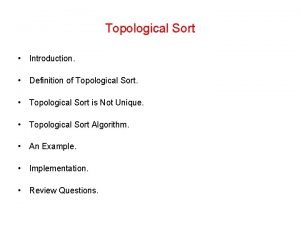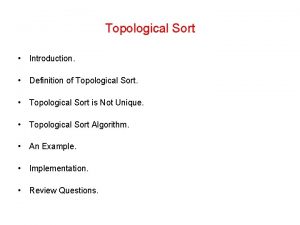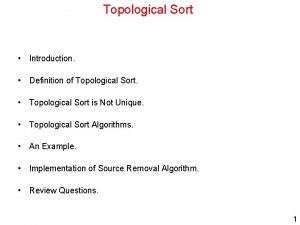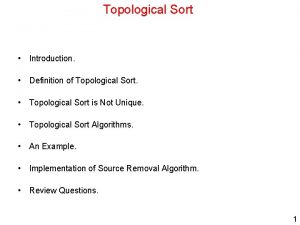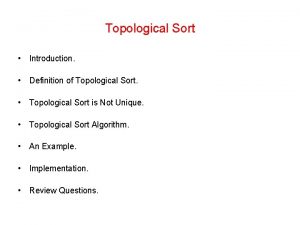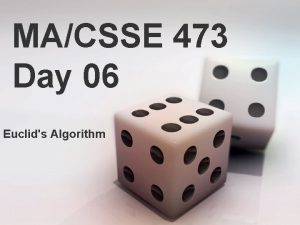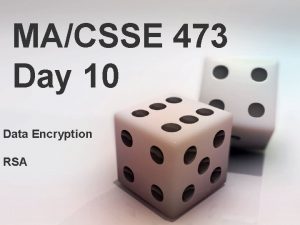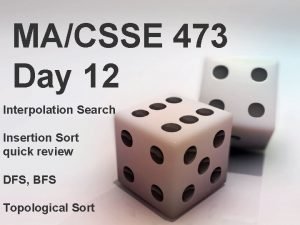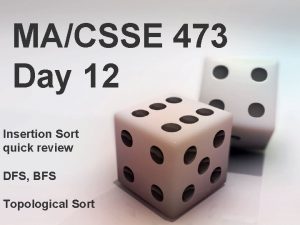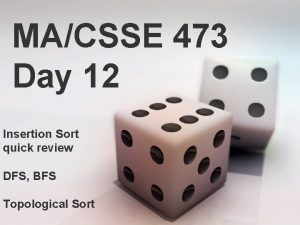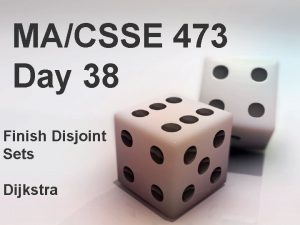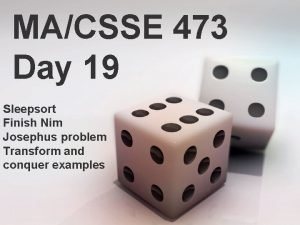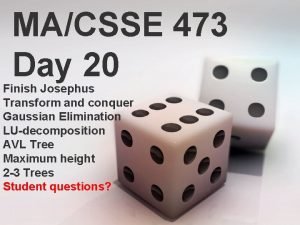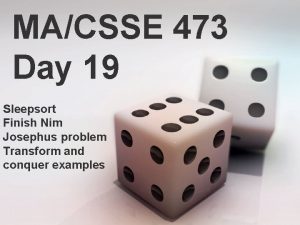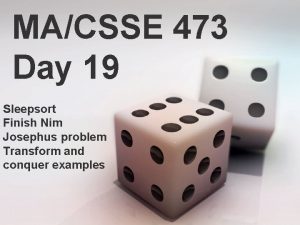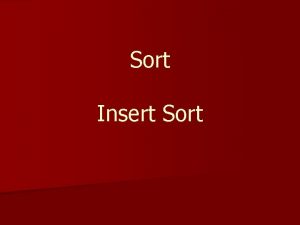MACSSE 473 Day 13 Finish Topological Sort Permutation





















- Slides: 21

MA/CSSE 473 Day 13 Finish Topological Sort Permutation Generation

MA/CSSE 473 Day 13 • Student Questions • Finish Topological Sort • Permutation generation

Recap: Topologically sort a DAG • DAG = Directed Aclyclic Graph • Linearly order the vertices of the DAG so that for every edge e, e's tail vertex precedes its head vertex in the ordering.

DFS-based Algorithm DFS-based algorithm for topological sorting – Perform DFS traversal, noting the order vertices are popped off the traversal stack – Reversing order solves topological sorting problem – Back edges encountered? → NOT a dag! Example: a b c d e f g h Efficiency:

Source Removal Algorithm Repeatedly identify and remove a source (a vertex with no incoming edges) and all the edges incident to it until either no vertex is left (problem is solved) or there is no source among remaining vertices (not a dag) Example: a b c d e f g h Efficiency: same as efficiency of the DFS-based algorithm

Application: Spreadsheet program • What is an allowable order of computation of the cells' values?

Cycles cause a problem!

Permutations Subsets COMBINATORIAL OBJECT GENERATION

Combinatorial Object Generation • Generation of permutations, combinations, subsets. • This is a big topic in CS • We will just scratch the surface of this subject. – Permutations of a list of elements (no duplicates) – Subsets of a set

Permutations • We generate all permutations of the numbers 1. . n. – Permutations of any other collection of n distinct objects can be obtained from these by a simple mapping. • How would a "decrease by 1" approach work? – Find all permutations of 1. . n-1 – Insert n into each position of each such permutation – We'd like to do it in a way that minimizes the change from one permutation to the next. – It turns out we can do it so that we always get the next permutation by swapping two adjacent elements.

First approach we might think of • for each permutation of 1. . n-1 – for i=0. . n-1 • insert n in position i • That is, we do the insertion of n into each smaller permutation from left to right each time • However, to get "minimal change", we alternate: – Insert n L-to-R in one permutation of 1. . n-1 – Insert n R-to-L in the next permutation of 1. . n-1 – Etc.

Example • Bottom-up generation of permutations of 123 • Example: Do the first few permutations for n=4

Johnson-Trotter Approach • integrates the insertion of n with the generation of permutations of 1. . n-1 • Does it by keeping track of which direction each number is currently moving The number k is mobile if its arrow points to an adjacent element that is smaller than itself • In this example, 4 and 3 are mobile

Johnson-Trotter Approach • The number k is mobile if its arrow points to an adjacent element that is smaller than itself. • In this example, 4 and 3 are mobile • To get the next permutation, exchange the largest mobile number (call it k) with its neighbor. • Then reverse directions of all numbers that are larger than k. • Initialize: All arrows point left.

Johnson-Trotter Driver

Johnson-Trotter background code

Johnson-Trotter major methods

Lexicographic Permutation Generation • Generate the permutations of 1. . n in "natural" order. • Let's do it recursively.

Lexicographic Permutation Code

Permutations and order number 0 1 2 3 4 5 6 7 8 9 10 11 permutation 0123 0132 0213 0231 0312 0321 1023 1032 1203 1230 1302 1320 number 12 13 14 15 16 17 18 19 20 21 22 23 permutation 2013 2031 2103 2130 2301 2310 3012 3021 3102 3120 3201 3210 • Given a permutation of 0, 1, …, n-1, can we directly find the next permutation in the lexicographic sequence? • Given a permutation of 0. . n-1, can we determine its permutation sequence number? • Given n and i, can we directly generate the ith permutation of 0, …, n-1?

Discovery time (with two partners) • Which permutation follows each of these in lexicographic order? – 183647520 471638520 – Try to write an algorithm for generating the next permutation, with only the current permutation as input. • If the lexicographic permutations of the numbers [0, 1, 2, 3, 4, 5] are numbered starting with 0, what is the number of the permutation 14032? – General form? How to calculate efficiency? • In the lexicographic ordering of permutations of [0, 1, 2, 3, 4, 5], which permutation is number 541? – How to calculate efficiently?
 Day 1 day 2 day 3 day 4
Day 1 day 2 day 3 day 4 Topological sort online
Topological sort online Topological sort bfs
Topological sort bfs Topological sort calculator
Topological sort calculator Topological sort algorithm
Topological sort algorithm Kahn's algorithm python
Kahn's algorithm python Gscc graph
Gscc graph Topological sort can be implemented by?
Topological sort can be implemented by? Topological sort calculator
Topological sort calculator Topological sort
Topological sort Topological sort pseudocode
Topological sort pseudocode Ioicamp
Ioicamp Strongly connected components
Strongly connected components Topological sort time complexity
Topological sort time complexity Topological sort
Topological sort Topological ordering
Topological ordering Graph topological sort
Graph topological sort Macsse
Macsse Macsse
Macsse Macsse
Macsse Macsse
Macsse Day 1 day 2 day 817
Day 1 day 2 day 817

